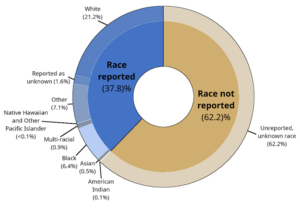REPRESENT DEI
Diversity of Research Participant Gender, Race, and Ethnicity in Communication Sciences and Disorders: A Systematic Review of ASHA Publications in 2020
Authors: Ryan A. Millager, Jacob I. Feldman, Zachary J. Williams, Kiiya Shibata, Keysha A. Martinez-Torres, Katherine M. Bryan, Dillon G. Pruett, Jade T. Mitchell, Jennifer E. Markfeld, Brandon Merritt, Derek E. Daniels, Robin M. Jones, and Tiffany Woynaroski
 RESEARCH QUESTIONS: How diverse is research in hearing and speech sciences, in terms of sex, gender, race, ethnicity, language, and socioeconomic status? How do scientists share demographic information in their published research? To begin answering these questions, a cross-departmental group of doctoral students, along with their PhD advisors, have developed a flexible coding tool for systematic review of published articles. We have looked at hearing and speech research as a whole (Millager et al., under review), and are currently looking at representation in sub-specialties such as autism, stuttering, and some types of dementia.
RESEARCH QUESTIONS: How diverse is research in hearing and speech sciences, in terms of sex, gender, race, ethnicity, language, and socioeconomic status? How do scientists share demographic information in their published research? To begin answering these questions, a cross-departmental group of doctoral students, along with their PhD advisors, have developed a flexible coding tool for systematic review of published articles. We have looked at hearing and speech research as a whole (Millager et al., under review), and are currently looking at representation in sub-specialties such as autism, stuttering, and some types of dementia.
 WHAT WE DID: We created a detailed and reliable process for reviewing scientific research and counting the demographic information made available in research studies. Looking at everything published in a single year, we have reviewed nearly 100 research articles in stuttering (internationally), and over 400 articles in hearing and speech overall that were published in American Speech-Language-Hearing Association journals (national).
WHAT WE DID: We created a detailed and reliable process for reviewing scientific research and counting the demographic information made available in research studies. Looking at everything published in a single year, we have reviewed nearly 100 research articles in stuttering (internationally), and over 400 articles in hearing and speech overall that were published in American Speech-Language-Hearing Association journals (national).

WHAT WE FOUND: We found that hearing and speech scientists do not always use similar approaches when measuring and reporting participant demographics (sex, gender, race, ethnicity, and socioeconomic status). For example, very few published articles (about 3%) differentiate between a person’s sex (which relates to a person’s biology) and their gender (which relates to their social role and personal identity). Also, Some important measures of diversity – such as race, ethnicity, and/or socioeconomic status – have been reported less than 50% of the time, which makes it hard to judge just how inclusive our science is. From what is reported, however, we expect that many traditionally underrepresented groups (such as Asian or American Indian people) are also underrepresented in our research.
IMPLICATIONS: Based on this work, we recommend that readers and clinicians think critically about who is included in scientific research. We also recommend that all researchers consider how they may best collect and report participant demographic information. By making it clear who is included in each study, we can increase all of our accountability toward creating a scientific literature that includes, and in turn benefits, as many different people as possible.